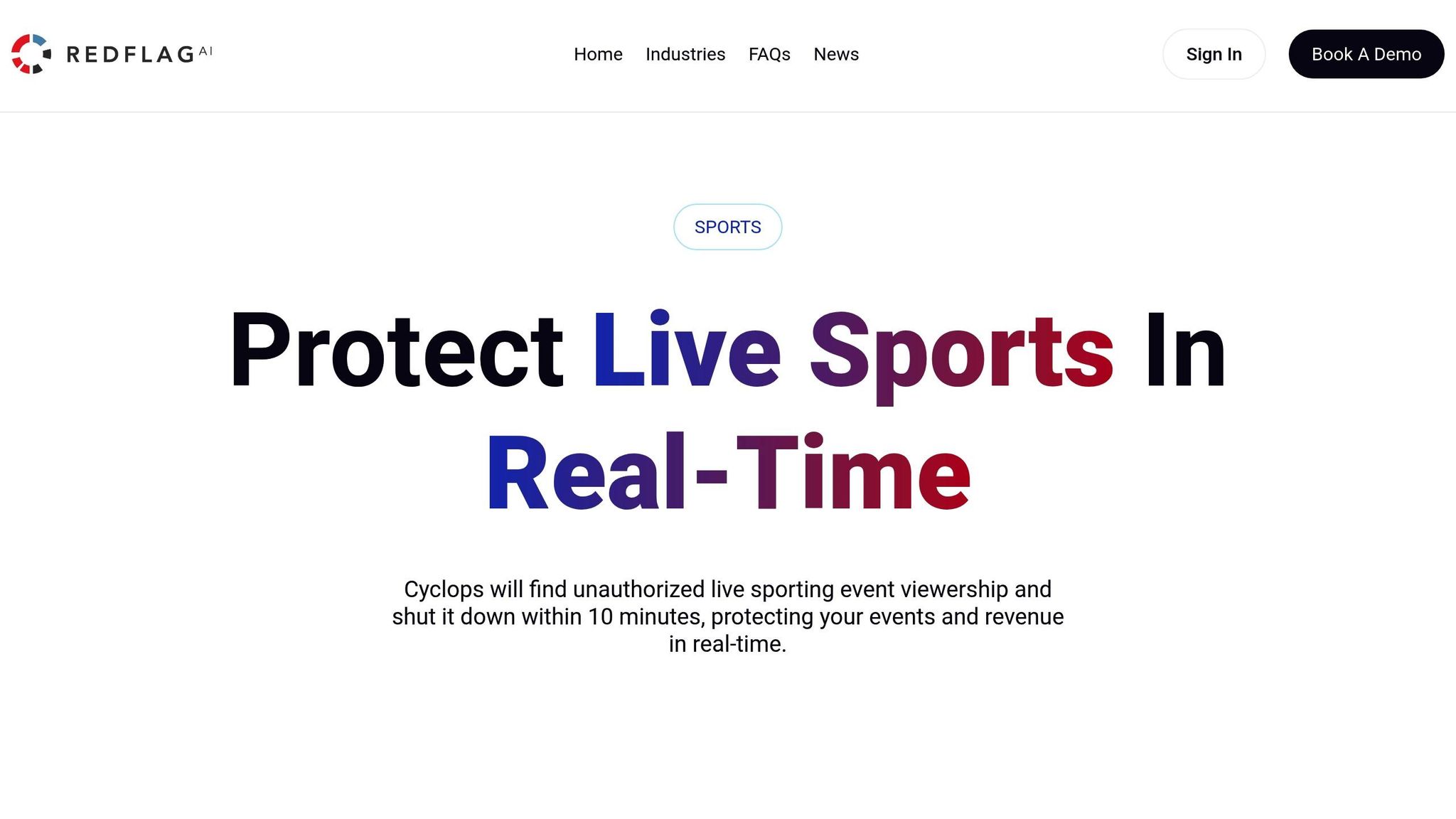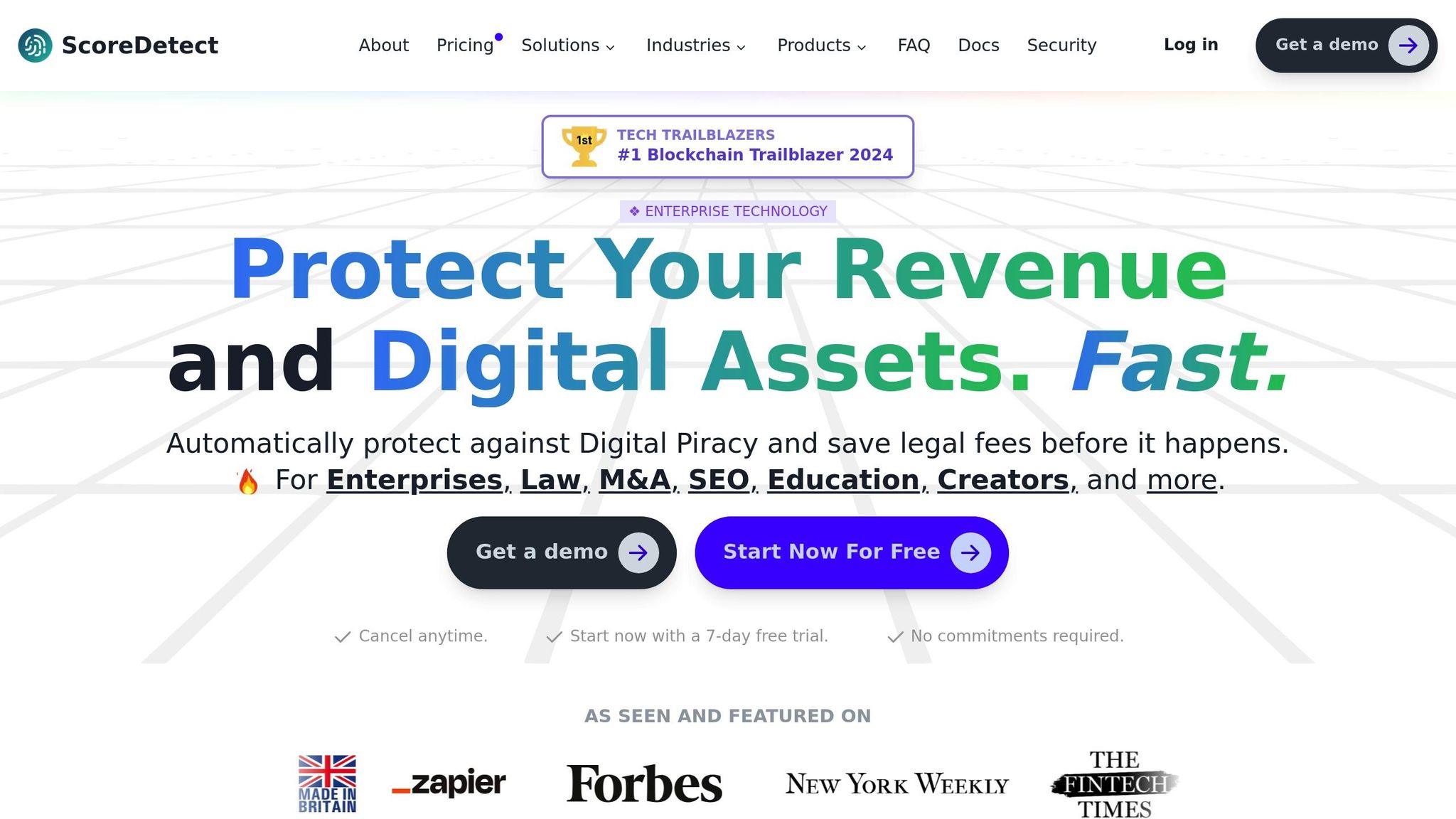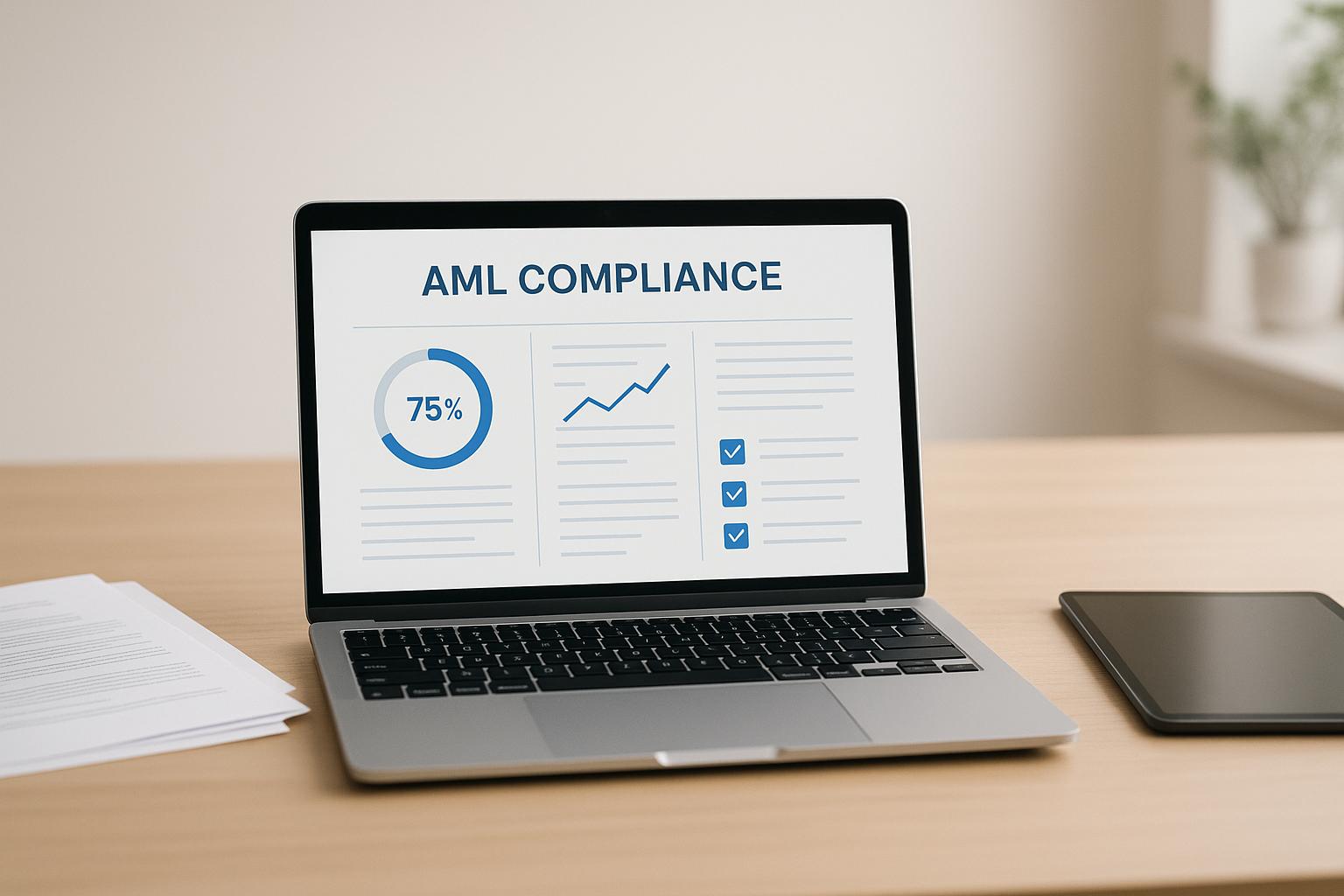Digital piracy is a $75 billion problem in 2025. It affects industries like media, software, and publishing, with piracy consuming 24% of global internet bandwidth. AI is now a critical tool to combat this issue, offering faster detection, accurate tracking, and stronger legal evidence. Key technologies include:
- AI-Driven Content Matching: Identifies pirated material by creating digital fingerprints for original content.
- Forensic Watermarking: Embeds invisible markers in files to prove ownership and track misuse.
- Blockchain Verification: Records copyright data securely, supporting legal claims and automating licensing.
Real-world tools like ScoreDetect combine these methods to protect digital assets effectively. However, challenges remain, like pirates leveraging AI to evade detection and ethical concerns around overblocking and data privacy. As piracy tactics evolve, businesses must act now to secure their content with AI-powered solutions.
RedFlag AI CEO Max Eisendrath On Creating a One-Stop Shop for Sports Content Protection

Core AI Technologies for Digital Piracy Prevention
The battle against digital piracy hinges on three key AI technologies that work together to provide a layered defense system. These advanced tools are designed to identify, track, and verify unauthorized online content. Let’s break down how each of these technologies plays a role in combating piracy.
AI-Driven Content Matching and Recognition
Modern AI algorithms excel at creating unique digital "fingerprints" for content. Using techniques like computer vision, audio recognition, and natural language processing, these systems can match original content with online material – even if it’s been altered, compressed, or reformatted.
Here’s how it works: the AI generates a digital fingerprint for the original file and scans the web to find matches. This enables quick identification of newly uploaded pirated material. Over time, these systems have become incredibly precise, making them indispensable for content creators and distributors who need reliable tools to protect their work.
Forensic Watermarking
Forensic watermarking embeds subtle, undetectable digital markers directly into files, creating a permanent link to the rightful owner. These watermarks persist through compression, format changes, editing, and even screen recording. This makes them an effective tool for proving ownership and tracking unauthorized distribution.
The process involves making minute changes to the content – such as altering pixel values in images or tweaking audio frequencies. These changes are invisible to the human eye or ear but can be detected by specialized algorithms. Because these watermarks remain intact across multiple copies, they serve as powerful evidence in cases of unauthorized sharing.
Blockchain for Copyright Verification
Blockchain technology records copyright data using cryptographic checksums and timestamps, offering legally reliable proof of creation and ownership without requiring storage of the actual digital assets.
Recent legal cases have highlighted the effectiveness of this approach. For instance, in March 2025, the Tribunal Judiciaire of Marseille accepted blockchain timestamps as evidence in the AZ Factory vs. Valeria Moda case. Blockchain-based records proved that the designs in question predated the alleged infringement [5]. Similarly, in January 2025, the U.S. Copyright Office granted registration to Invoke AI’s "A Single Piece of American Cheese", a digital artwork. Blockchain timestamps and a time-lapse video showed the human creative input behind the piece [5].
Beyond verification, blockchain enables smart contracts to automate licensing and royalty payments. When paired with AI, these systems can detect potential copyright violations and trigger verification processes. As Duncan Roberts, Senior Manager at Cognizant Research, explains:
"Intellectual property management is a strong blockchain use case. Who created a given bit of content? Who should be rewarded for its use? Blockchain is useful anytime you need verification of a database" [4].
Key Benefits of AI in Digital Piracy Prevention
AI-powered systems are redefining how digital assets are protected, offering unmatched speed, precision, and scalability. These strengths translate into clear advantages in detection, scalability, and legal evidence.
Automated Detection and Rapid Takedown
AI’s ability to automate the detection and takedown of pirated content is a game-changer. Instead of relying on manual searches that can take days, AI scans millions of web pages, social platforms, and file-sharing sites in real time. It identifies copyright violations within minutes and issues takedown notices automatically. Even better, AI can proactively spot content likely to spark copyright disputes before it spreads widely online [8]. On top of that, it streamlines licensing negotiations between creators and rights holders, saving time and effort [8].
Scalability and Accuracy
One of the biggest challenges with traditional anti-piracy efforts is scalability. Human analysts can only review a limited number of cases each day, but AI eliminates this bottleneck. It processes enormous volumes of data quickly, saving both time and resources. AI also delivers a higher level of accuracy, reducing the chances of errors. By identifying complex patterns and avoiding the biases often present in manual reviews, AI ensures more precise results [6][7].
Stronger Legal and Quantitative Proof
AI doesn’t just detect piracy – it builds a rock-solid case. These systems generate comprehensive forensic evidence that can hold up in court, far surpassing the subjective assessments and limited documentation of traditional methods. AI can track timestamps of unauthorized uploads, document distribution reach, calculate damages based on metrics like views and downloads, and maintain detailed audit trails of enforcement actions. It also uncovers hidden patterns that traditional methods might miss [7].
This quantitative insight provides businesses with a clear picture of how piracy impacts their bottom line, offering data on the extent of unauthorized content distribution and its financial effects. Together, these capabilities create a dynamic defense system that evolves with piracy tactics while equipping businesses with the evidence needed for successful legal action.
sbb-itb-738ac1e
ScoreDetect: A Leading Example of AI-Powered Anti-Piracy Solutions

ScoreDetect shows how AI can shift digital content protection from being reactive to proactive. Created by Michael Bryan Sumner, this platform combines several AI-driven techniques to deliver a robust anti-piracy solution. It addresses the growing demand for automated tools to combat piracy, building on the AI approaches mentioned earlier.
Key Features and Capabilities of ScoreDetect
ScoreDetect operates through four main processes:
- Prevention Layer: This feature uses invisible watermarking to embed undetectable markers into digital content. These markers discourage illegal use without affecting the quality or user experience.
- Discovery Component: Advanced web scraping technology enables the platform to bypass 95% of anti-scraping defenses. This ensures continuous monitoring and real-time detection of unauthorized content usage.
- Analysis Capabilities: The system compares detected content with the original, providing solid quantitative evidence of infringement. This data can be used to support legal actions and enforce copyright.
- Automated Takedown System: With a success rate of over 96%, this feature sends delisting notices automatically, ensuring swift removal of pirated content.
Additionally, ScoreDetect incorporates blockchain technology to record content checksums. This creates tamper-proof ownership records without storing the actual digital files.
Industries That Benefit from ScoreDetect
ScoreDetect caters to a wide range of industries, each with unique content protection needs:
- Media and Entertainment: Protects video content, music, and digital publications from piracy.
- Legal Professionals: Offers verifiable proof of ownership and infringement to strengthen intellectual property cases.
- Marketing, Advertising, and SEO Agencies: Safeguards creative assets while enhancing online credibility with blockchain-based proof of ownership.
- Academic and Educational Institutions: Secures research publications and intellectual assets.
- Ecommerce Businesses: Protects product information and digital catalogs.
- Healthcare Organizations: Ensures the security of sensitive data and research findings.
Integration and Workflow Automation
ScoreDetect goes beyond its core features by offering seamless integration options. For example:
- WordPress Plugin: Automatically timestamps published or updated articles on the blockchain, providing proof of ownership and improving SEO performance.
- Zapier Integration: Connects ScoreDetect with over 6,000 web applications to automate workflows.
- Developer API: Enables businesses to integrate ScoreDetect’s content protection tools directly into their content management systems or digital asset platforms.
ScoreDetect provides flexible pricing plans. The ScoreDetect Pro plan starts at $11.31 per month (billed annually) and includes unlimited websites and blockchain timestamping. For enterprises, the ScoreDetect Enterprise plan offers advanced features like 24/7 monitoring, comprehensive watermarking, and automated takedown notifications.
Challenges and Ethical Considerations in AI-Based Anti-Piracy
While AI brings powerful tools to the fight against digital piracy, it’s important to recognize that pirates are also harnessing these technologies to outmaneuver detection systems. This creates a complex landscape filled with challenges and ethical dilemmas for organizations looking to combat piracy effectively.
Evolving Tactics of Digital Pirates
Pirates have become increasingly sophisticated, using AI to automate content scraping and sidestep detection. Premium content can now appear on illegal sites within minutes, making traditional reactive approaches ineffective.
The financial toll is staggering. The entertainment industry faces global losses estimated at $71 billion annually, and in the U.S. alone, streaming piracy rates are expected to climb from 22% in 2022 to 24.5% by 2027 [10]. What’s more, piracy is no longer a fringe activity – illegal streaming platforms now attract millions of paying users.
To make matters worse, pirates are employing advanced techniques like screen recording and insider collusion to bypass defenses. They’re even leveraging AI to create slight variations of pirated content, complicating detection efforts [9]. Countering these tactics demands AI systems capable of real-time adjustments, enhanced training methods, and robust encryption. However, such measures must strike a delicate balance between automation and human intervention.
Balancing Automation with Oversight
AI-driven anti-piracy systems are incredibly efficient, but they’re not without risks. Overreliance on automation can lead to errors, such as mistakenly flagging legitimate content – commonly referred to as overblocking. Striking the right balance between accuracy and efficiency is critical.
YouTube’s Content ID system offers a cautionary example. A study found that 83.4% of unavailable YouTube content was flagged by automated systems, yet only 5% of these cases involved actual copyright violations [14]. This highlights the potential for automated measures to overreach.
To address this, organizations should adopt human-in-the-loop (HITL) systems, where human reviewers assess and correct AI outputs in sensitive situations. Rule-based interventions that prioritize human review, along with interfaces that clarify uncertainties and offer alternative solutions, can improve decision-making [13]. Additional safeguards, such as AI governance committees, real-time monitoring, and clear accountability structures, ensure that these systems operate responsibly [15].
Legal and Privacy Implications
As organizations refine their oversight of AI systems, they must also navigate the intricate legal and privacy challenges these tools present. Data privacy laws like GDPR and CCPA impose strict requirements for handling personal data, even when it’s used for legitimate anti-piracy purposes [12].
Legal professionals face unique challenges when using AI in intellectual property cases. Rawia Ashraf from Thomson Reuters notes:
"When litigators use generative AI to help answer a specific legal question or draft a document specific to a matter by typing in case-specific facts or information, they may share confidential information with third parties, such as the platform’s developers or other users of the platform, without even knowing it." [11]
To mitigate these risks, the American Bar Association advises lawyers to carefully review AI tools’ terms of use, privacy policies, and other relevant agreements. Jessica Brand, Senior Specialist Legal Editor at Thomson Reuters, adds:
"Because opposing counsel may upload discovery documents and information into GenAI for a variety of purposes, including summary and analysis, attorneys should consider including confidentiality provisions in discovery agreements to protect against the inadvertent disclosure or retention of their clients’ confidential information." [11]
Organizations must implement strong safeguards, such as encryption, access controls, and data anonymization, to protect sensitive information while maintaining AI effectiveness. Transparency is also key. Clear privacy policies should explain how data is collected, used, and protected. Regular security audits and penetration testing can help identify vulnerabilities and strengthen defenses.
Training employees on data privacy best practices is equally important. This ensures that teams understand their responsibilities when working with AI-powered systems. Establishing ethical governance frameworks and oversight committees further reinforces accountability and responsible use of AI in anti-piracy efforts.
The Future of AI in Digital Piracy Prevention
The fight against digital piracy has entered a new era, with artificial intelligence taking center stage. As piracy methods become more advanced and financial losses escalate, businesses must recognize AI as a crucial tool for safeguarding their digital assets. Here’s why AI-driven anti-piracy measures are becoming indispensable.
Key Takeaways
AI-powered solutions are no longer a luxury – they’re a necessity for businesses aiming to protect their content. The numbers speak for themselves: piracy costs are soaring, with billions of unauthorized views reported annually [3]. Traditional methods simply can’t keep up.
Nearly 67% of companies admit they struggle to counteract the latest piracy tactics [16]. Modern pirates are leveraging AI to automate content scraping and evade detection, leaving outdated defenses ineffective.
Tools like ScoreDetect highlight the potential of AI in this space. Its invisible watermarking, efficient web scraping, rapid takedown processes, and blockchain verification represent the future of proactive protection. From education and media to finance and healthcare, industries are increasingly reliant on such advanced, automated solutions.
"Most people in the industry are aware that the biggest competitor for OTT platforms is piracy. Period." [1]
Looking Ahead
The future of AI in piracy prevention is shaped by a fast-evolving technological arms race. As one expert puts it:
"Content Piracy in 2025 or even future years is expected to become more complicated as technology, especially AI, continues to advance." [3]
This growing complexity stems from pirates using AI-powered tools to clone voices, replicate artistic styles, and produce convincing imitations of copyrighted material.
The global Anti-Piracy Protection market is projected to hit $454.43 million by 2033 [16]. This growth reflects the increasing recognition of the need for advanced protection technologies. Key trends driving this expansion include real-time piracy detection using AI, the adoption of cloud-based solutions, and stronger intellectual property laws and enforcement measures [17].
However, challenges are mounting. Decentralized networks and anonymous platforms make detecting and addressing piracy more difficult [17]. Pirates are also using encrypted messaging apps and VPNs to bypass traditional detection systems. These advanced tactics demand constant innovation in anti-piracy technology [17].
Stricter regulatory frameworks are on the horizon [2], pushing for enhanced security practices like Zero Trust Architecture and greater focus on supply chain security. Businesses will need to adopt more robust measures, including vendor assessments and secure data-sharing protocols [2].
For companies, the time to act is now. As Maria "Mascha" Malinkowitsch advises:
"Providers need to have partners who are on top of such threats and know how they operate. AI must be embraced as a tool to use against AI-based piracy. After all, if pirates depend upon AI, so should you to maximize the protections for your high-value content." [1]
This highlights the urgent need for stronger defenses, tighter regulations, and global cooperation as the battle against piracy intensifies [3].
FAQs
How is AI-powered content matching more effective than traditional methods in detecting pirated material?
AI-driven content matching outshines traditional methods thanks to its speed and accuracy. Older techniques, like manual searches or static fingerprinting, often fall short when faced with the massive scale of online content and the constantly evolving methods used by pirates. AI, on the other hand, can process enormous amounts of data in mere seconds, spot disguised or altered content through advanced pattern recognition, and adjust to new obfuscation techniques.
This adaptability means AI can uncover pirated material even when it’s been altered – whether cropped, reformatted, or embedded into other media. By automating the detection process, AI not only speeds things up but also delivers more dependable results, offering a powerful tool to protect digital assets and tackle piracy effectively.
What ethical challenges arise when using AI to prevent digital piracy, and how can they be managed?
Using AI to tackle digital piracy brings up several ethical questions, particularly around consent and fair compensation for content creators. Many AI systems depend on copyrighted material, which can lead to conflicts if permissions aren’t properly secured. On top of that, handling sensitive or proprietary information with AI introduces risks to privacy and data security, potentially leaving such data vulnerable to misuse or unauthorized access.
To navigate these issues, organizations need to prioritize transparency, obtain the necessary licenses for using content, and enforce strong data protection protocols. Striking the right balance between technological advancement and respecting creators’ rights, as well as safeguarding user privacy, is key to promoting ethical AI practices.
How does blockchain technology strengthen copyright protection in digital piracy cases?
Blockchain plays a key role in safeguarding copyright by establishing an unchangeable, time-stamped record of ownership and usage rights. This digital ledger acts as a trustworthy source, ensuring that ownership claims can be verified and protected from tampering – offering strong legal support in case of disputes.
Instead of storing the actual digital assets, blockchain records a cryptographic checksum of the content. This approach boosts transparency and trust while keeping the assets secure. It’s an effective solution for protecting intellectual property and tackling piracy in a dependable and secure manner.

